Discover The National Palace Of Pena Which Is A Sintra Marvel In 2025
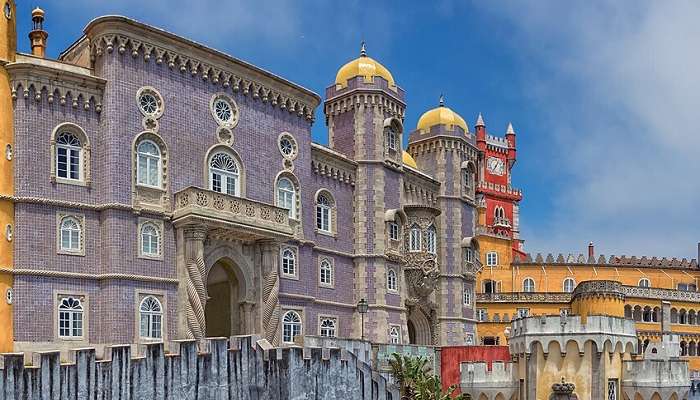
Perched atop a hill in Sintra, Portugal, the National Palace of Pena stands as a masterpiece of 19th-century Romanticism. This whimsical castle, with its vibrant colours and eclectic architectural styles, seems plucked from a fairy tale. King Ferdinand II transformed a ruined monastery into this summer retreat, blending Gothic, Manueline, Moorish, and Renaissance elements. The palace’s striking exterior is matched by lavish interiors that transport visitors to a bygone era of royal luxury. Surrounded by lush forests and offering panoramic views of the Portuguese countryside, the National Palace of Pena is a testament to human creativity and a must-see destination for history enthusiasts and dreamers alike.
About The National Palace Of Pena

The Pena Palace (Portuguese: Quinta da Regaleira (also known as Palácio da Pena) is a unique building of the Romanticist style of architecture situated in São Pedro de Penaferrim, in the Sintra district of Portugal, on the Portuguese Riviera. Located in the Sintra Mountains, the palace is on a hill and is easily visible from Lisbon and most of the metropolitan area on clear days. The palace also has a stunning view.
This architectural wonder is not only a national landmark but also one of the most important examples of the Romanticism of the nineteenth century in the entire world. Being a part of the UNESCO World Heritage list, the Pena Palace is one of the Seven Wonders of Portugal. It has many bright colours, very different from most of the buildings we see nowadays, and has a rich history.
The palace is also used as a residence for the President of the Portuguese Republic and other state functions. If you are interested in architecture and history or just want to find a beautiful place to visit, the Pena Palace will be interesting and valuable.
Also Read: Hidden Gems In Portugal
History Of The National Palace Of Pena
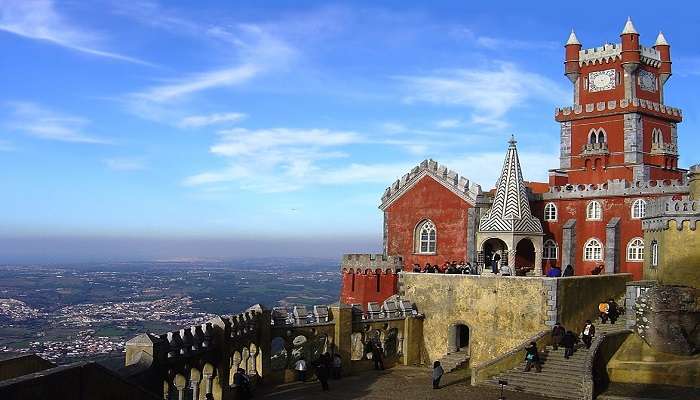
The history of the National Palace of Pena started in the Middle Ages when a chapel of Our Lady of Pena was built on a hill of Sintra after the apparition of the Virgin. In 1493, John II and his wife Leonor of Viseu visited the site, and Manuel I built a monastery for the Order of Saint Jerome. The monastery could accommodate up to eighteen monks; it was struck by lightning in the 18th century and almost completely destroyed by the earthquake of 1755.
In 1838, King Consort Ferdinand II bought the ruins and the surrounding area and, with the help of Wilhelm Ludwig von Eschwege, turned the monastery into a Romantic-style palace. The palace changed hands several times after the death of Ferdinand and was only bought by the Portuguese State in 1889. After the Republican Revolution of 1910, it was declared a national monument and museum. The palace, which has red and yellow as its dominant colours, was repainted to its original colours before the end of the twentieth century and was listed as a UNESCO World Heritage site in 1995.
Architecture Of The National Palace Of Pena
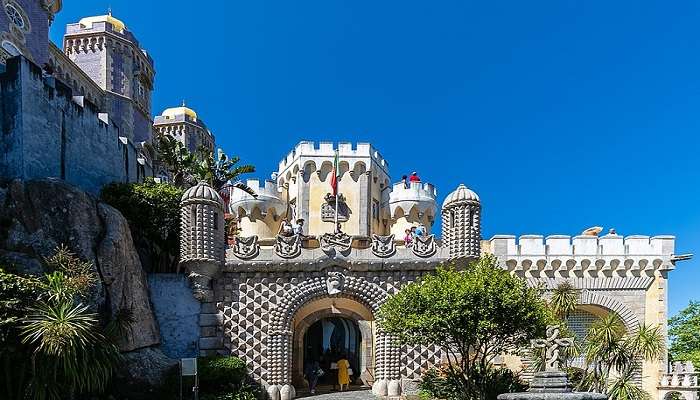
The National Palace of Pena is situated in the Sintra Mountains and is a beautiful example of Romantic architecture that incorporates Neo-Gothic, Neo-Manueline, Neo-Islamic and Neo-Renaissance styles. This eclectic mix was introduced during major renovations in the 1840s. The palace is built on rock, and it can be divided into four main parts.
These are the structural sections of the building that have the enveloping walls and gateways, the restored old convent and clock tower, the Arches Yard with Moorish arches, and the palatial zone with a cylindrical bastion and cathedral-like interiors. The section of the convent has been preserved with the cloister and chapel; the wide terrace and the clock tower were added in 1843. The Queen’s Terrace provides a view of the architectural design of the palace, and it also has a sundial cannon that is used to shoot at midday.
Related Post: Portugal Travel Guide
Things To Do Inside The National Palace Of Pena
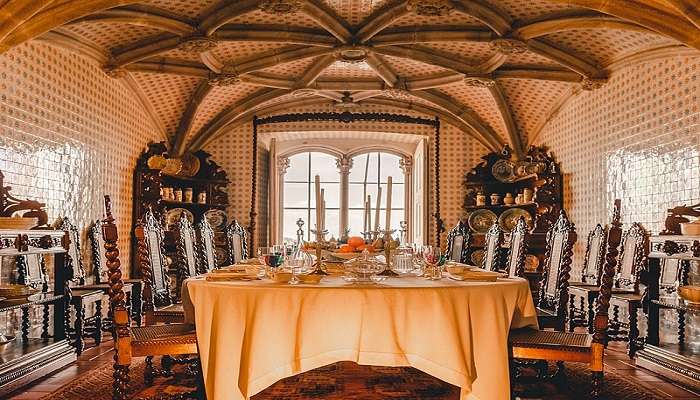
The National Palace of Pena in Sintra, Portugal, is a breathtaking example of 19th-century Romanticism. Here are three must-see highlights inside the palace:
Royal Rooms: Visit the luxurious staterooms such as the Royal Dining Room, the Noble Room and the bedrooms. These rooms are furnished with beautiful pieces of furniture, adorned with beautiful artworks and have complicated designs, where one can get a glimpse of the lifestyle of the Portuguese royal family.
Manueline Cloister: This beautiful and calm cloister demonstrates the rich and detailed features of Manueline’s style of construction. It is an interesting place within the palace owing to its intricate stonework and its historical background.
Queen’s Office and King Carlos’ Chambers: Learn more about the royal family’s lifestyle by going to the Queen’s Office, which is done in the Queen’s favourite style and the Chambers of King Carlos, which gives some information about the king’s personal life and hobbies.
Entrance Fees And Timings

The National Palace of Pena offers a delightful experience for visitors. Entrance fees are €14 for adults and €12.50 for children and seniors, with the option to purchase tickets online in advance. During the summer season (April to October), the palace is open from 9:45 AM to 7:00 PM and the park from 9:30 AM to 8:00 PM. It’s advisable to arrive early in the morning as it can get crowded. In the winter season (November to March), both the palace and park are open from 10:00 AM to 6:00 PM. Enjoy your visit
Related Post: National Parks In Portugal
How To Reach?
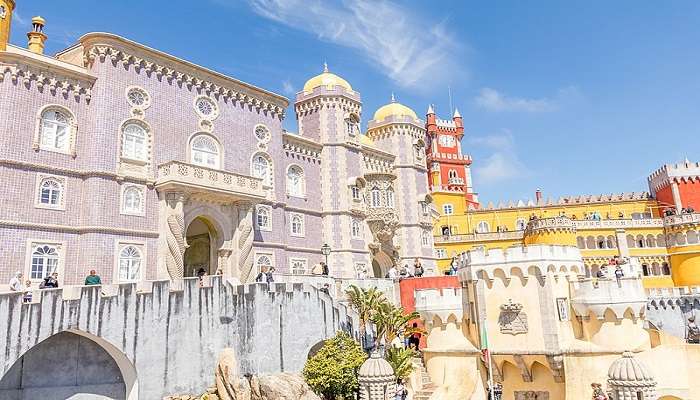
Various modes of transportation can be used to reach the National Palace of Pena (Palácio Nacional da Pena) in Sintra, Portugal. Here are the ways to reach this magnificent site:
By Bus
The closest bus stop to the National Palace of Pena is Palacio da Pena, which is only 500 meters away. Buses from various points in Sintra can reach this stop, making it convenient for visitors.
By Train
The nearest train station to the Palace is Sintra, located 3.1 km away. From the Sintra Estação stop outside the train station, you can take a bus to the Palacio da Pena halt and then walk 500 meters to the Palace. This combination of train and bus travel offers a scenic and efficient way to reach your destination.
By Car
If you’re driving from Lisbon, start by taking the N249 road. Turn into Av. Conde Sucena 2 até ao Bairro Alto da Boavista, then continue on N375 for 20 minutes. Turn right onto Escadinhas de Santa Maria 6, take the Rampa do Castelo 12 or 2, and then switch to Estrada da Pena, which will take you to the Palace. The whole trip should take about 40 minutes, offering a direct and convenient way to travel.
By Tuk Tuk
Take a tuk-tuk to the National Palace of Pena from any bus or train station for an unforgettable experience. Be careful of drivers overcharging; it should cost no more than 10 euros per person from anywhere in Sintra. This way of travelling adds a special and exciting touch to your trip.
You May Also Like To Read: National Parks In Portugal
The National Palace of Pena is a testament to Portugal’s rich history and architectural brilliance. From its lush gardens to its opulent interiors, the palace offers a glimpse into King Ferdinand II’s romantic vision and the country’s cultural heritage. As you plan your next adventure, consider immersing yourself in the fairytale-like atmosphere of this extraordinary landmark. Ready to experience the magic of Sintra for yourself? Book your trip to Portugal today and Explore the amazing National Palace of Pena and its beautiful surroundings.
For our editorial codes of conduct and copyright disclaimer, please click here.
Cover Image Credit: Ray in Manila for Wikimedia Commons
Frequently Asked Questions About National Palace Of Pena
What are some facts about the Palace of Pena?
The Palace of Pena, completed in 1854, is a Romanticist castle in Sintra, Portugal. Known for its eclectic architecture and stunning hilltop views, it is a UNESCO World Heritage Site, offering a picturesque setting overlooking the surrounding environment.
Why is Pena Palace painted red and yellow?
The vibrant colours of the Palace of Pena are a nod to its rich history. The original monastery was painted red, while the newer sections of the palace were painted yellow. In 1994, these colours were meticulously restored to honour King Ferdinand II’s original vision.
Who built the National Palace of Pena?
King Ferdinand II of Portugal built the National Palace of Pena. He transformed the ruins of a former monastery into a palace, with construction beginning in 1838, creating a remarkable blend of architectural styles.
What king lived in Pena Palace?
King Ferdinand II resided in Pena Palace until he died in 1885. Subsequently, King Luís I purchased the palace, which continued to serve as a summer residence for the Portuguese royal family, reflecting its royal heritage.
How old is the Palace of Pena?
Construction of the Palace of Pena began in 1839 and was completed in 1854, making it approximately 170 years old. Its rich history and architectural significance have contributed to its status as a beloved landmark in Portugal.
People Also Read:
Mandir Palace Jaisalmer Famous Palaces In India Padmanabhapuram Palace

With a passion for exploring and travelling to the roads long forgotten, experience the world through enthralling stories and adventures. Join me as I share my experiences at some of the world’s most popular tourist destinations and quench that pestering curiosity with something exciting!











